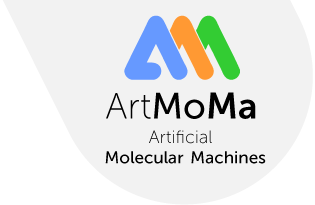Welcome on board, Maximilian !
Maximilian Fellert will be joining the Feringa lab at the University of Groningen in September 2020 as an Early Stage Researcher. In the framework of the ArtMoMa network, Maximilian will work on Molecular Swimmers Using Motor Driven Flagella while participating in many ArtMoMa training and network events. Before starting his research in the Netherlands, Maximilian explains why he wanted to join the network:
Tell us more about your background!
My name is Maximilian Fellert, I am 25 years old and was born in Germany. I finished my Bachelor studies in chemistry at the Heinrich Heine University Düsseldorf, including a Bachelor thesis on the cyclopropanation of nucleobases (Prof. C. Czekelius).
For my Master’s studies, I moved to the Ludwig-Maximilians-University Munich focusing on organic and inorganic chemistry as well as chemical biology as my majors. In this regard, a research internship in Munich introduced me to the field of protein characterization by NMR spectroscopy (Prof. R. Linser).
Throughout my Master studies, I had the chance to gain further research experience in high-level research groups in Europe. On the one hand, I performed an internship on the synthesis of 2nd generation molecular motors driven by visible light at the University of Groningen (Prof. B. Feringa). On the other hand, I explored the field of inorganic chemical biology during an internship on the synthesis of novel Ru(II)polypyridyl complexes as anti-cancer agents at Chimie ParisTech/PSL University in Paris (Dr. G. Gasser).
Finally, for my Master thesis, I moved to Zurich to broaden my knowledge on method development and catalysis, working on a novel Pd-catalyzed aryl-acylation methodology at the ETH Zurich (Prof. B. Morandi).
Why did you want to be a part of ArtMoMa?
What has always excited me about synthetic (organic) chemistry is the mixture of creativity and craft skills. On one side, a lot of expertise and creativity is required to plan and perform a synthesis, as well as to overcome obstacles on the way to the target compound. On another side, a considerable amount of the synthetic chemist’s working time is spent on acquiring hands-on experience in methodology and chemistry as craft work. I am looking forward to further advance these skills during my upcoming Ph.D. as there are many synthetic and analytical methodologies to explore.
After 20 years of fundamental research, the ArtMoMa ITN aims to transform this fundamental knowledge into applications such as medicinal chemistry or material science, giving me the perfect opportunity to conduct my Ph.D. in my favored research area: molecular motors and machines. There is still a long way to go to achieve the application of molecular motors and machines, but I am happy to join ArtMoMa as a consortium of highly talented and motivated early researchers as well as well-experienced mentors and advisors that aim to achieve this goal.
What are your expectations of living and working in your host city?
During my research internship in Groningen, I have fallen in love with this beautiful Dutch city. I enjoy the possibility to reach every part of the city by bike within 20 minutes as well as the open-minded, hospitable and liberal lifestyle of the Dutch people. Although the weather sometimes is rainier than one would like, Groningen offers close access to the sea and the Frisian islands, as well as parks and a city beach to enjoy sunny hours. Finally, I am looking forward to exploring the hidden but lovely places that I have not seen so far.
What do you think will be your main challenge for you in the next three years?
I believe that the upcoming three years will hold both personal and scientific sub-challenges for me. Pursuing Ph.D. research will sometimes be difficult and is connected to experiencing a lot of ups and downs – days when you are highly excited about your research, and those days where all experiments fail. Keeping my head up and knowing when to sometimes stop, to take a step back, to reconsider what I have done, to allow myself to make mistakes and to learn from them will be challenging – but hopefully an achievable goal for my time as a Ph.D. student.
From a scientific perspective, enabling molecular motors to be applied in biological contexts or in material science will be adjunct to shift the excitation wavelength into the upper part of the visible spectrum or even the (near-)infrared region – which, in turn, requires extensive synthetic design. Other challenging aspects will be the adjustment of rotational speed and efficiency – as well as seemingly simple aspects such as the solubility in water, to allow for applications in biological contexts. Such obstacles need to be overcome in order to induce and apply molecular motion by light.




